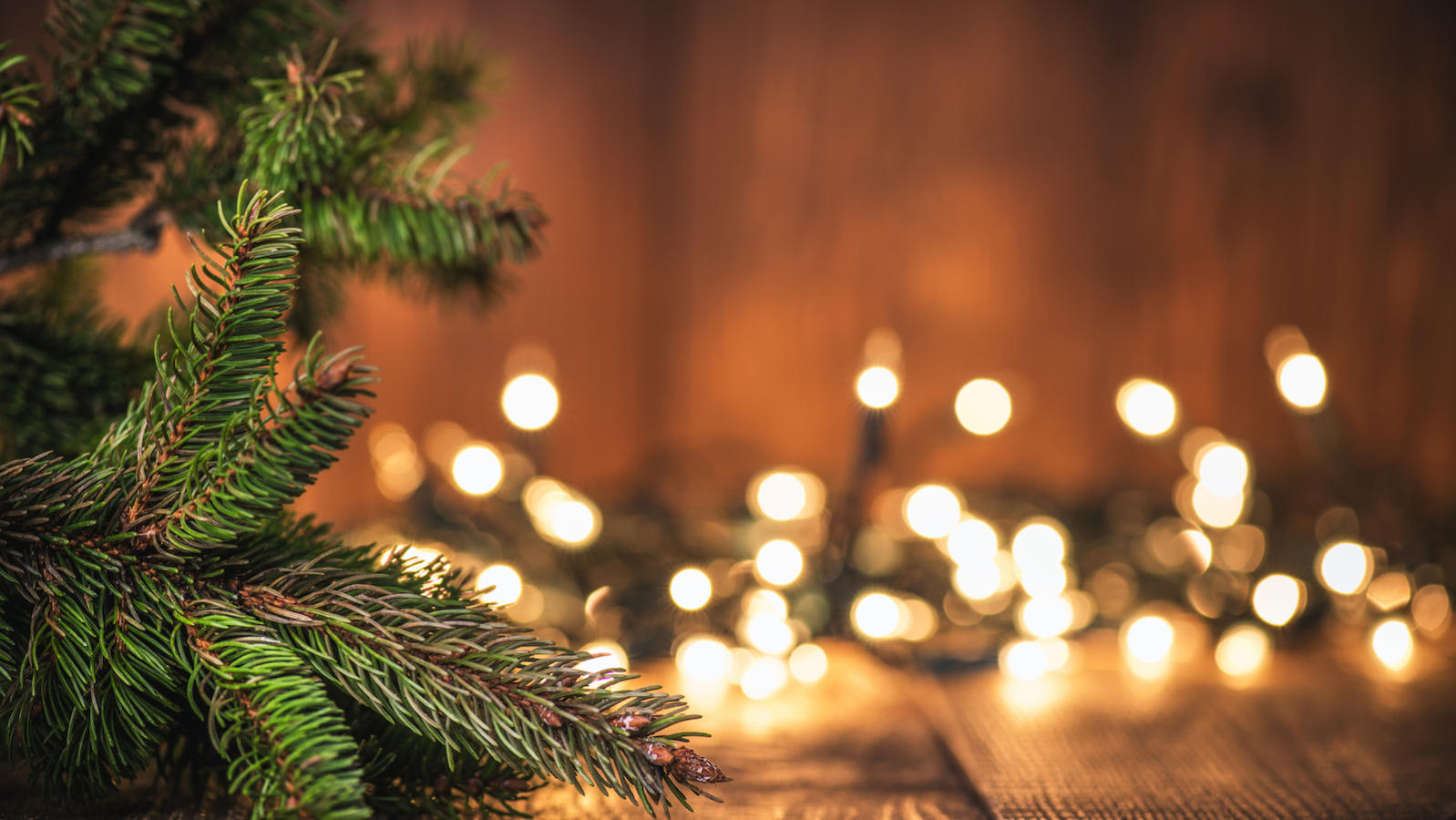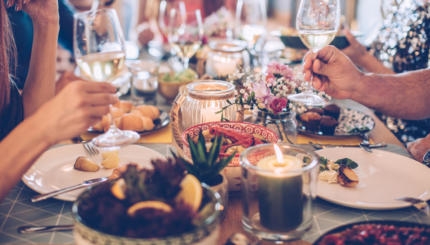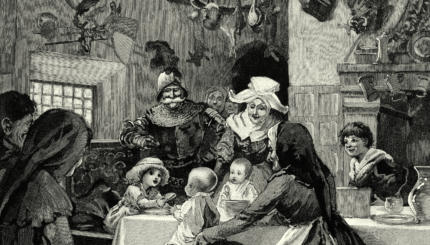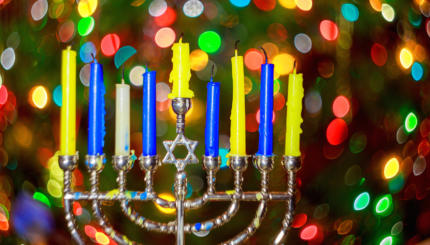For the majority of Americans, December 25 is a time to celebrate the birth of Jesus, but for Jews it is a time to consider ones relationship to the wider society. Some Jews have chosen to adopt the Yuletide festivities. Some have emphatically rejected the rituals and symbols of Christmas. Still others have sought ways to meld Christmas and Hanukkah.
Christmas, in effect, has become a prism through which Jews can view how living in this land of freedom has shaped our religion, culture, and identity.
Christmas in Europe
For centuries, the Jews of Central and Eastern Europe feared Christmas-time. At any other time, pious Jews would be studying Torah in the synagogue, but not on Christmas. Wary of being attacked in the street, they took refuge in their homes, playing cards or chess with their families.
The story was different in Western Europe, where, for the Jewish elite, holiday symbols — such as the Christmas tree — signified secular inclusion in society. Affluent German Jews often posed for portraits with their extended families in front of elaborately decorated Christmas trees. The Viennese socialite Fanny Arnstein, a co-founder of the Music Society of Austria, was among the first Jews to introduce a Christmas tree into the home, an act also practiced by none other than the father of modern Zionism, Theodor Herzl. Indeed, after Herzl completed his seminal book on Zionism in 1895, Vienna’s chief rabbi visited him at his home during the month of December. This historically significant meeting took place with a Christmas tree in view.
With your help, My Jewish Learning can provide endless opportunities for learning, connection and discovery.
In Berlin, the great scholar of Jewish mysticism, Gershom Scholem, grew up in a home that celebrated Christmas “with roast goose or hare, a decorated Christmas tree which my mother bought at the market by St. Peter’s Church, and the big distribution of presents for servants, relatives, and friends…An aunt who played the piano treated our cook and servant girl to ‘Silent Night, Holy Night.'” These celebrations, Scholem believed, reflected the view that Christmas was “a German national festival, in the celebration of which we joined not as Jews but as Germans.” As a young adult, Scholem would reject his family’s celebration and, instead, attend a Maccabee ball for single Jews in Berlin — a matchmaking idea that has as its modern counterpart the Matzo Ball, a party for Jewish singles held in cities throughout North America.
Coming to America
As early as the 1870s, Christmas in America began to change from essentially a religious to a secular national holiday — a process accelerated by commercialization and the custom of gift-giving.
In response, some Jewish families in New York, San Francisco, Boston, Hot Springs, Baltimore, New Orleans, and Toledo staged their own celebrations on the night of December 24. Incorporating both Christmas and Hanukkah symbols, regardless if Hanukkah fell earlier or later on the calendar, they decorated Christmas trees, exchanged gifts, and hung wreaths on the doors of their homes and stockings on the fireplace. In addition, from the 1880s to the beginning of World War II, American Jews of German descent hosted balls — featuring dinner, dancing, and a concert — for their Jewish friends on Christmas Eve.
Those Jews sharing in the tenor of Christmas without partaking in its religious elements would engage in selective borrowing of Yuletide accoutrements, lending a festive spirit to Hanukkah by appropriating decorations such as garlands, wreaths, and evergreen boughs. Consider Sinai Congregation of Chicago’s celebration of Hanukkah, as reported in the December 27, 1878 issue of Chicago’s Jewish Advance:
The fine Temple was crowded with grown people and children. The Hanukkah Tree was brilliantly illuminated with wax candles. The services commenced with the singing of the first stanza of the Hanukkah hymn by the Sabbath-school children.
So, too, the Sabbath Visitor, a popular Jewish children’s magazine of the time, encouraged the decorative use of evergreens during the Festival of Lights. A story in the 1880 edition entitled “On Last Christmas” describes a Jewish family’s celebration of Hanukkah; home decorations included pictures of Moses and George Washington, a menorah covered with flowers, and the liberal use of wreaths and evergreens.
Perhaps the most widely appropriated Christmas custom among Jews was gift giving. The 1931 how-to classic What Every Jewish Woman Should Know, for example, included the following advice:
It is a time hallowed Jewish custom to distribute gifts in honor of the Hanukkah festival. If ever lavishness in gifts is appropriate, it is on Hanukkah. Jewish children should be showered with gifts, Hanukkah gifts, as a perhaps primitive but most effective means of making them immune against envy of the Christian children and their Christmas.
Sociological Significance
What were the consequences for Jews who embraced Christmas traditions? Starting in the 1950s, American Jewish sociologists conducted a number of studies. In his 1958 study of second-generation immigrant Reform Jews on Chicago’s South Side, clinical psychologist and rabbi Milton Matz revealed that in the second generation parents often agreed that a Jewish child might need a Christmas tree to “hyphenate the contradiction between his Americanism and his Jewish ethnicism.” Matz’s study also demonstrated that members of the third generation were increasingly likely to recognize the inherent contradiction in adopting the religious symbols of another group; they would eventually give up the Christmas tree and find other ways of expressing their acculturation into American society.
Sure enough, in a 1993 study Stanford religious studies professor Arnold M. Eisen validated Matz’s findings, demonstrating that the majority of American Jews no longer had Christmas trees. In 82 percent of Jewish households in which all members were Jewish, a Christmas tree had never been displayed. So too, sociologist Marshall Sklare’s research in the 1950s and ’60s on second- and third-generation Jews established that Hanukkah — formerly a “minor” Jewish holiday — had gained in importance when it became the Jewish alternative for Christmas.
“Instead of alienating the Jews from general culture,” wrote Sklare, “Hanukkah helps to situate him as a participant in that culture. Hanukkah, in short, becomes for some the Jewish Christmas.” Ironically, by elevating Hanukkah as a Jewish alternative to Christmas, American Jews had invented their own holiday tradition through a Christmas mirror.
The Christmas Mitzvah Season
One of the main ways of publicly proclaiming one’s Jewish identity in response to Christmas fever centered on the time-honored practice of “doing mitzvot“– charitable deeds that one’s Christian neighbors were also expected to do in “the spirit of Christmas.”
A January 8, 1886 article in the American Israelite described this phenomenon:
It is the custom here [Cincinnati], as in other cities, to provide a hearty meal for all the poor children of the vicinity during the Christmas holidays, also to give each child presents, in the shape of toys, candies, books, etc. Some of our leading citizens form themselves into a club to manage the affair…Many of our Hebrew families, recognizing that the movement was to make children happy, set aside all questions of faith and doctrine and contributed very liberally in money and material. In fact, so bountifully did they subscribe, that public notice had to be given that no more gifts could be received from any quarter.
For decades, volunteerism has been a way for Jews to embrace the Christmas spirit, while enabling Christians to celebrate their holiday. In so doing, Jews respond in a new way to Christmas consciousness — proudly proclaiming Jewish identity in the face of seasonal marginality.
The Jewish Santa
Perhaps the most ironic manifestation of the Christmas mitzvot phenomenon is the Jewish volunteer in a Santa suit. For more than 20 years, Harvey Katz, a lawyer from Glastonbury, Connecticut and a member of Congregation Kol Haverim, delighted children with his cheerful “ho-ho-ho” at the only place in town with a Santa — the Glastonbury Bank and Trust Company (where he served as the first Jewish trustee).
Jay Frankston of New York City also took up the role of Santa in 1960, at first to amuse his children. Later, upon discovering that the third floor of the city’s main post office served as the storage place for letters addressed to Santa Claus, he managed to gain access to the letters and decided to send telegrams to eight of the children saying, “Santa is coming.” Dressed as Santa, Frankston then made good on the promise, bringing the delighted children their presents. By 1972, he was providing gifts to 150 children. Publicity about Frankston’s good deeds attracted donations–donations that he, in turn, gave to charitable organizations to distribute at Christmas. “Before, Christmas didn’t belong to me,” Frankston explained. “Now, Christmas belongs to me.”
Today, thousands upon thousands of American Jews have become vested in Christmas through the doing of mitzvot — volunteering in soup kitchens and hospitals, visiting the homebound, preparing or delivering Christmas meals, buying Christmas presents for the poor, or substituting for colleagues at work. Increasingly, volunteerism has become an established means of combining the Jewish value of tikkun olam, repairing the world, with the Christmas message of bringing joy to the world.
Who would have imagined that this once-feared holiday would become an occasion for many American Jews to proudly affirm their identity both as Americans and as Jews?
Hanukkah
Pronounced: KHAH-nuh-kah, also ha-new-KAH, an eight-day festival commemorating the Maccabees' victory over the Greeks and subsequent rededication of the temple. Falls in the Hebrew month of Kislev, which usually corresponds with December.
menorah
Pronounced: muh-NOHR-uh, Origin: Hebrew, a lamp or candelabra, often used to refer to the Hanukkah menorah, or Hanukkiah.



